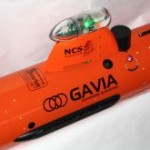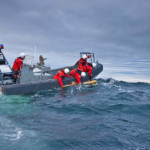USCG Cutter Found by ICG

Sixty-seven years after being torpedoed by a German U-boat in January 1942, the final resting place of the Treasury Class US Coast Guard Cutter Alexander Hamilton WPG-34 was finally identified in early September 2009 during an Icelandic Coast Guard operation utilising a Gavia AUV. The Alexander Hamilton became the first US loss in the Atlantic after the Pearl Harbour attacks
(7 December 1941) while escorting a convoy to Iceland and within sight of land. Shortly after receiving a new aircraft with specialised pollution detection equipment in July 2009, the Icelandic Coast Guard (ICG) detected traces of oil on the surface invisible to the naked eye and in an area not known to contain any wrecks. Soon after, a survey vessel was dispatched to the area which carried out a multi-beam sonar survey using a relatively low frequency system. Although surveying large swathes of the ocean bottom, the instrument does not provide much resolution on contact. However, this survey did reveal an uncharted wreck. As a result of these findings, a subsequent operation was planned with the ICG Cutter Ægir in order to identify the wreck. Objectives also included obtaining higher resolution side-scan sonar and bathymetric data from a Gavia AUV and video footage from an accompanying Remotely Operated Vehicle (ROV).
On 31 August 2009, despite windy conditions and sea state 4-5, it was decided to press on with the operation due to ICG vessel availability. The Gavia AUV was operated from a RIB from the ICG Cutter Ægir. Small boat operations in those conditions were quite difficult for the AUV operators, presenting challenges for both launch and recovery and, to a greater extent, the visual relocation of the vehicle (even with a known GPS position of the vehicle) due to the high swells and limited visibility.
The Gavia AUV that was utilised during the operation was equipped with a 600kHs side-scan sonar and a 500kHz GeoSwath module was also employed. As the Gavia AUV is a modular system, it was possible to insert the GeoSwath module when required. A DVL-aided Inertial Navigation System was used for navigation.
From the data gathered, it was possible to determine that the vessel is lying on its starboard side at an approximately 45 degree angle in around 95 metres depth. It was also possible to see the evidence of the massive damage from the torpedo, which left a 11-metre long hole in the bottom of the ship. Further video data from the ROV of the ships’ running gear determined that this was undoubtedly the Alexander Hamilton.
According to Captain Halldór Nellet, Chief of Operations ICG, “The Gavia AUV proved to be a powerful tool in the Icelandic Coast Guards’ identification of the Alexander Hamilton, providing us with a clearer picture of the vessel in its entirety. We could view the damage sustained and how the wreck lies on the sea bottom. The Hamilton was originally presumed to have gone down considerably to the south of the position where she was found.
According to Arnar Steingrimsson, Marketing Manager at Hafmynd, “Hafmynd Ehf is pleased to have
been able to play a role in the discovery of the Alexander Hamilton in conjunction with the Icelandic Coast Guard and to properly mark the final resting place of these twenty US Coast Guard sailors. We thank the men of the Hamilton and countless others for their service and the sacrifices made by them and their families during this dark time; you are not forgotten.”
Hafmynd also wishes to thank the US Coast Guard for the valuable assistance with historical drawings and images of the Alexander Hamilton.







